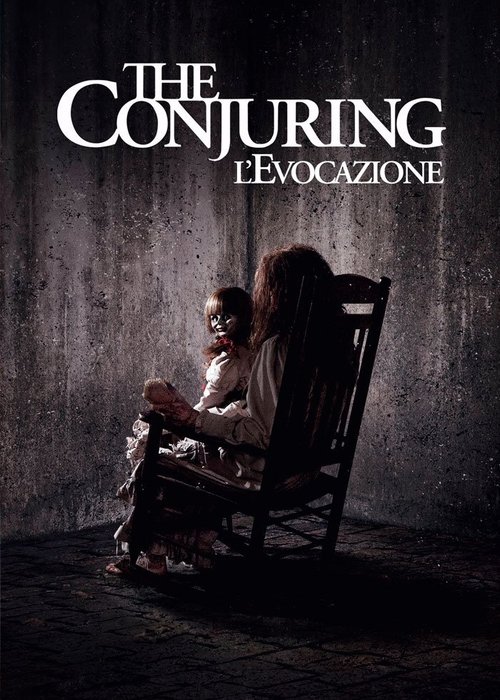RG
Roberto Giacomelli
•The Conjuring
1971, Harrisville, Rhode Island. Roger and Carolyn Perron, along with their five daughters and their dog, have just moved into a large house in the countryside, right on the edge of a lake. The house, which dates back to the late 19th century, has something sinister about it, and it is the dog who notices it first, hesitating to set foot inside. After the mysterious death of the animal, strange events begin to occur within the house: eerie noises, unexplained presences, and Carolyn waking up every morning with a new bruise on her body. At this point, she decides to seek help from the Warrens, world-renowned paranormal investigators who teach at the local university. As soon as Lorraine Warren sets foot in the Perrons' house, she is able to identify a malevolent entity that seems to have dangerously attached itself to Carolyn, threatening the entire family.
One of the most prolific genres in horror cinema is undoubtedly that of haunted houses, a genre that has given us genuine masterpieces and cult classics over the years, from "The Uninvited", "The Haunting", "The Innocents", and "House on Haunted Hill", to the 1970s revival with "The Amityville Horror", "Burnt Offerings", and "The Legend of Hell House", along with all the variations and influences this genre can encompass. On reflection, haunted houses are one of the foundational tropes of the horror genre, central to many terrifying stories that have scared both young and old throughout history. This theme is doubly threatening because it not only involves the paranormal but also undermines the one place where a human being can truly feel safe: their home, often acquired through years of hard work and savings. In the horror imagination, the symbol of safety, security, and financial investment transforms into a sanctuary of all evils.
It is by tapping into this deeply ingrained imagery, explored and elaborated in hundreds of stories and films, that James Wan, director of hits like "Saw" and "Insidious", chooses to create his new film, "The Conjuring". At first glance, Wan's new work might seem like a melting pot of clichés from the genre, but upon closer inspection, it becomes clear that the film's great strength lies precisely in its intelligent anchoring to an imagery deeply rooted in every horror film enthusiast.
"The Conjuring" begins exactly as one would expect a haunted house movie to begin: with a family moving into a new, large, dilapidated house in the middle of nowhere. From that moment on, Wan gathers all the clichés of the genre and condenses them into about an hour, presenting them without giving the audience a moment's respite. There are several truly memorable moments, such as the clever idea of the "hide-and-clap" game – which provides the basis for a couple of well-crafted scare scenes – and the terrifying scene of the presence behind the door, one of the most genuinely frightening cinematic moments in recent years. Then, about halfway through the film, "The Conjuring" shifts gears, much like Wan did with his previous film "Insidious", but it does so seamlessly, transitioning into the possession film genre, reminiscent of "Amityville II: The Possession". In the midst of all this, there is also the idea of introducing a second family, the Warrens, professional "ghost hunters" who, first working alone (with an excellent prologue about the case of the possessed doll) and then teaming up with the Perrons, try to rid the haunted house of its malevolent presence.
What many people may not know is that the Warrens – like the Perrons – actually existed (Lorraine Warren, still alive, served as a consultant for the screenplay), and the story told in "The Conjuring" represents one of the most famous cases they worked on (notably, the Warrens also worked on the Amityville case and the Connecticut case that inspired the film "The Haunting in Connecticut").
Bringing the characters to life is a talented cast led by Vera Farmiga ("Up in the Air", "Joshua") and Lily Taylor ("The Haunting", "The Addiction"), followed by Patrick Wilson ("Insidious", "Watchmen") and Ron Livingston ("Dinner for Schmucks"). But the film's crowning achievements are John Leonetti's cinematography and Joseph Bishara's original score, both seasoned collaborators of Wan, as well as Wan's own direction, which masterfully creates the right atmosphere, aided by the Hayes brothers' screenplay, a perfect manual of fear.
Despite relying on the easy clichés of the "haunted house" genre, "The Conjuring" is a film rich in atmosphere and genuinely capable of frightening its audience. It is a cinematic primer of fear that works terrifyingly well and holds the viewer's attention for nearly two hours. It proves that even a story told many times before, if executed with skill and awareness, can be incredibly effective. Well done, Wan!
Fun fact: The monster haunting the Perron house is played by the film's composer, Joseph Bishara, who also portrayed the red-faced demon in "Insidious".










